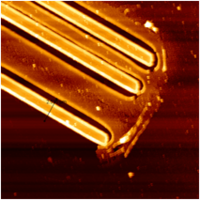The access to thermolabile precious metal compounds enables us to investigate the potential of these compounds for precious metal structuring. The required structure is strongly influenced by the desired application: Catalytic activity requires nanoscopic structuring of the precious metals, for electronic applications it is of high importance that metals are structured in form of layers or conducting pathways. In contrast to the well established lithographic procedures we developed a procedure for the texturing of Gold in which the structures are "written" with the help of an electron beam (Fig. 1).

Fig. 1: Electron beam induced Gold structuring
Suitable Precursors are complex nitrates of the composition (NO)[Au(NO3)4] and (NO2)[Au(NO3)4], which are available from the reaction of elemental Gold and N2O5. The application of carbon free precursors is very beneficial to achieve neat and contamination free structures. The decomposition of these compounds may be initiated with an electron beam or even thermally. The thermolysis is astonishingly complex as could be revealed by XPS investigations (Fig. 2). Recently we were able to synthesize the respective nitrato complexes of Palladium and Platinum. The investigation of the precursor potential of these compounds is part of actual research in the working group. The operations in this field are done in cooperation with the working groups of Prof. Al-Shamery (Physical chemistry, University of Oldenburg) and Prof. Fatikow (Engineering science, University of Oldenburg).

Fig. 2: Temperature dependent XPS investigations of the decomposition of (NO)[Au(NO3)4] show the energy change for the 4f7/2- und 4f5/2- states of Gold during the degradation of the precursor. The arrows in the left diagram show regions of the strongest changes. The right part of the picture shows spectra before and after the decomposition of the precursor.

Abb. 1: Elektronenstrahl induzierte Goldstrukturierung
Bei den Precursoren handelt es sich um komplexe Nitrate der Zusammensetzung (NO)[Au(NO3)4] und (NO2)[Au(NO3)4], die aus elementarem Gold und N2O5 zugänglich sind. Auch hier erweist sich der Einsatz kohlenstofffreier Precursor als ausgesprochen vorteilhaft für den Erhalt sehr sauberer, d.h. kontaminationsfreier Strukturen. Die Zersetzungen dieser Verbindungen können nicht nur im Elektronenstrahl erfolgen, sondern auch thermisch initiiert werden. Die Thermolyse verläuft dabei erstaunlich komplex, wie XPS-Untersuchungen zeigen (Abb. 2). Kürzlich ist es uns gelungen, auch von Palladium und Platin die entsprechenden Nitratokomplexe zu synthetisieren. Diese werden gegenwärtig hinsichtlich ihres Precursorpotentials untersucht. Die Arbeiten dieses Schwerpunktes erfolgen in Kooperation mit den Arbeitsgruppen von Frau Prof. Al-Shamery (Physikalische Chemie, Universität Oldenburg) und Herrn Prof. Fatikow (Ingenieurswissenschaften, Uni Oldenburg).

Abb. 2: Temperaturabhängige XPS-Untersuchungen an (NO)[Au(NO3)4] zeigen die Änderung der Energie für die 4f7/2- und 4f5/2-Zustände des Goldes bei Zersetzung des Precursors. Die Pfeile im linken Diagramm zeigen die Regionen der stärksten Änderung. Im rechten Teil der Abbildung sind die Spektren vor und nach der Zersetzung des Precursors gezeigt